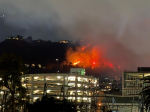
Amidst the towering steel bars of the US-Mexico border fence near San Diego, a surge of migrants from various corners of the globe gathers, seeking passage onto US soil.
With supplies piled high in makeshift tents, volunteers like Adriana Jasso await the tired and hungry travelers who have journeyed for weeks or even months to reach California.
This stretch of the border, previously less traversed, has become one of the busiest entry points along the US-Mexico frontier. While the issue of illegal border crossings has long been centered in Texas, recent statistics indicate a significant shift westward to border states like Arizona and California. In San Ysidro, just south of affluent San Diego, crossings surged by 85% in February compared to the previous year, contrasting with a decline in Texas during the same period.
Several factors contribute to this migration pattern shift, including Texas's crackdown on illegal migration and heightened security measures by Mexican authorities. The influx of migrants, overwhelming local resources, has led to the release of up to 1,000 individuals daily at city train and bus stops after processing near the border.
As migrants line up for intake, stripping off excess clothing and belongings, the strain on California's southern border becomes palpable. The sheer volume of arrivals has strained communities and elevated immigration to the forefront of political discourse. Across battleground states, immigration ranks among the top concerns for voters, with many expressing dissatisfaction with current policies and border security.
Despite California's Democratic stronghold status, a majority of registered voters share concerns about border security. Former President Donald Trump, pointing fingers at President Joe Biden's administration, accuses them of exacerbating the situation. Biden's efforts to curb illegal crossings, including lifting pandemic-era policies, have faced challenges, with technical issues hampering proposed solutions.
The Biden administration's approach, aiming to encourage legal asylum claims while addressing push factors like violence and poverty, faces practical and political hurdles. Local officials, like Nora Vargas of San Diego County, have grappled with the influx, advocating for transitional centers to aid migrants while awaiting processing. However, funding shortages have forced closures, exacerbating the strain on local resources.
In San Ysidro and beyond, migrants, driven by diverse motivations ranging from political instability to economic opportunity, navigate uncertain futures. As the debate over immigration intensifies, the human stories behind the statistics underscore the complexities and challenges of managing the ongoing crisis at the US-Mexico border. Photo by Sgt. 1st Class Gordon Hyde, Wikimedia commons.






































